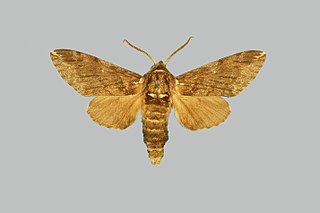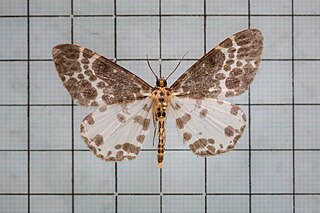
The Ryūkyū scops-owl or elegant scops-owl is a small rufous-brown owl with a brown face disk and a cinnamon facial ruff. The bill is olive-grey and it has yellow eyes.

Circobotys is a genus of moths of the family Crambidae.

Thliptoceras is a genus of moths of the family Crambidae. The genus was erected by William Warren in 1890.

Dolbina elegans, the ash hawkmoth, is a moth of the family Sphingidae. The species was first described by Andreas Bang-Haas in 1912. It is found from Ukraine, Moldavia, through eastern Romania and eastern and southern Bulgaria, northern Greece, western and southern Turkey to northern Syria, western Jordan, Israel, northern Iraq and northern Iran.

Dilophodes elegans is a moth in the family Geometridae first described by Arthur Gardiner Butler in 1878. It is found in Japan, China, Taiwan, north-eastern Himalaya, Burma and Borneo.
Circobotys cryptica is a moth in the family Crambidae. It was described by Eugene G. Munroe and Akira Mutuura in 1969. It is found in Japan.
Circobotys elongata is a moth in the family Crambidae. It was described by Eugene G. Munroe and Akira Mutuura in 1969. It is found in Taiwan.
Circobotys plebeia is a moth in the family Crambidae. It was described by Eugene G. Munroe and Akira Mutuura in 1969. It is found in Shaanxi, China.
Circobotys malaisei is a moth in the family Crambidae. It was described by Eugene G. Munroe and Akira Mutuura in 1970. It is found in Myanmar.
Circobotys arrogantalis is a moth in the family Crambidae. It was described by Tams in 1927. It is found in China (Sichuan).

Circobotys aurealis is a moth in the family Crambidae. It was described by John Henry Leech in 1889. It is found in Japan and Taiwan.
Circobotys brevivittalis is a moth in the family Crambidae. It was described by George Hampson in 1996. It is found in India.

Circobotys flaviciliata is a moth in the family Crambidae. It was described by George Hampson in 1910. It is found in the Democratic Republic of the Congo.
Circobotys heterogenalis is a moth in the family Crambidae. It was described by Otto Vasilievich Bremer in 1864. It is found in Japan and the Russian Far East.
Circobotys limbata is a moth in the family Crambidae. It was described by Frederic Moore in 1888. It is found in Darjeeling, India.
Circobotys nigrescens is a moth in the family Crambidae. It was described by Frederic Moore in 1888. It is found in Darjeeling, India.
Circobotys occultilinea is a moth in the family Crambidae. It was described by Francis Walker in 1863. It is found on Borneo and in India and Australia, where it has been recorded from Queensland and the Northern Territory.
Circobotys sinisalis is a moth in the family Crambidae. It was described by Francis Walker in 1859. It is found in the Democratic Republic of the Congo, Kenya and South Africa, where it has been recorded from the Eastern Cape.
Dichomeris elegans is a moth in the family Gelechiidae. It was described by Kyu-Tek Park in 2001. It is found in Taiwan.





